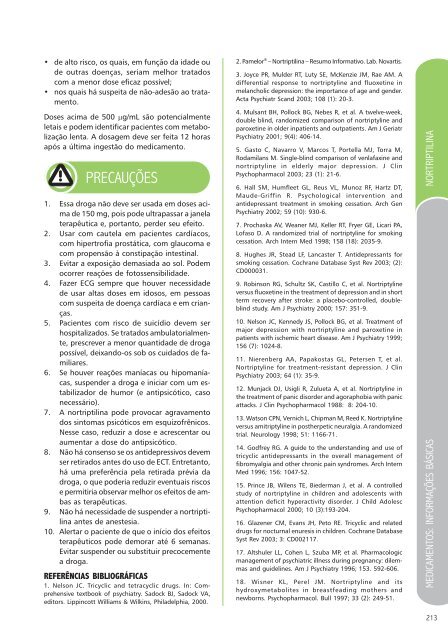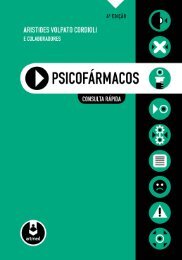Consulta Rápida - Psicofármacos - 1Ed.pdf
You also want an ePaper? Increase the reach of your titles
YUMPU automatically turns print PDFs into web optimized ePapers that Google loves.
• de alto risco, os quais, em função da idade ou<br />
de outras doenças, seriam melhor tratados<br />
com a menor dose eficaz possível;<br />
• nos quais há suspeita de não-adesão ao tratamento.<br />
Doses acima de 500 μg/mL são potencialmente<br />
letais e podem identificar pacientes com metabolização<br />
lenta. A dosagem deve ser feita 12 horas<br />
após a última ingestão do medicamento.<br />
PRECAUÇÕES<br />
1. Essa droga não deve ser usada em doses acima<br />
de 150 mg, pois pode ultrapassar a janela<br />
terapêutica e, portanto, perder seu efeito.<br />
2. Usar com cautela em pacientes cardíacos,<br />
com hipertrofia prostática, com glaucoma e<br />
com propensão à constipação intestinal.<br />
3. Evitar a exposição demasiada ao sol. Podem<br />
ocorrer reações de fotossensibilidade.<br />
4. Fazer ECG sempre que houver necessidade<br />
de usar altas doses em idosos, em pessoas<br />
com suspeita de doença cardíaca e em crianças.<br />
5. Pacientes com risco de suicídio devem ser<br />
hospitalizados. Se tratados ambulatorialmente,<br />
prescrever a menor quantidade de droga<br />
possível, deixando-os sob os cuidados de familiares.<br />
6. Se houver reações maníacas ou hipomaníacas,<br />
suspender a droga e iniciar com um estabilizador<br />
de humor (e antipsicótico, caso<br />
necessário).<br />
7. A nortriptilina pode provocar agravamento<br />
dos sintomas psicóticos em esquizofrênicos.<br />
Nesse caso, reduzir a dose e acrescentar ou<br />
aumentar a dose do antipsicótico.<br />
8. Não há consenso se os antidepressivos devem<br />
ser retirados antes do uso de ECT. Entretanto,<br />
há uma preferência pela retirada prévia da<br />
droga, o que poderia reduzir eventuais riscos<br />
e permitiria observar melhor os efeitos de ambas<br />
as terapêuticas.<br />
9. Não há necessidade de suspender a nortriptilina<br />
antes de anestesia.<br />
10. Alertar o paciente de que o início dos efeitos<br />
terapêuticos pode demorar até 6 semanas.<br />
Evitar suspender ou substituir precocemente<br />
a droga.<br />
REFERÊNCIAS BIBLIOGRÁFICAS<br />
1. Nelson JC. Tricyclic and tetracyclic drugs. In: Comprehensive<br />
textbook of psychiatry. Sadock BJ, Sadock VA,<br />
editors. Lippincott Williams & Wilkins, Philadelphia, 2000.<br />
2. Pamelor ® – Nortriptilina – Resumo Informativo. Lab. Novartis.<br />
3. Joyce PR, Mulder RT, Luty SE, McKenzie JM, Rae AM. A<br />
differential response to nortriptyline and fluoxetine in<br />
melancholic depression: the importance of age and gender.<br />
Acta Psychiatr Scand 2003; 108 (1): 20-3.<br />
4. Mulsant BH, Pollock BG, Nebes R, et al. A twelve-week,<br />
double blind, randomized comparison of nortriptyline and<br />
paroxetine in older inpatients and outpatients. Am J Geriatr<br />
Psychiatry 2001; 9(4): 406-14.<br />
5. Gasto C, Navarro V, Marcos T, Portella MJ, Torra M,<br />
Rodamilans M. Single-blind comparison of venlafaxine and<br />
nortriptyline in elderly major depression. J Clin<br />
Psychopharmacol 2003; 23 (1): 21-6.<br />
6. Hall SM, Humfleet GL, Reus VL, Munoz RF, Hartz DT,<br />
Maude-Griffin R. Psychological intervention and<br />
antidepressant treatment in smoking cessation. Arch Gen<br />
Psychiatry 2002; 59 (10): 930-6.<br />
7. Prochaska AV, Weaner MJ, Keller RT, Fryer GE, Licari PA,<br />
Lofaso D. A randomized trial of nortriptyline for smoking<br />
cessation. Arch Intern Med 1998; 158 (18): 2035-9.<br />
8. Hughes JR, Stead LF, Lancaster T. Antidepressants for<br />
smoking cessation. Cochrane Database Syst Rev 2003; (2):<br />
CD000031.<br />
9. Robinson RG, Schultz SK, Castillo C, et al. Nortriptyline<br />
versus fluoxetine in the treatment of depression and in short<br />
term recovery after stroke: a placebo-controlled, doubleblind<br />
study. Am J Psychiatry 2000; 157: 351-9.<br />
10. Nelson JC, Kennedy JS, Pollock BG, et al. Treatment of<br />
major depression with nortriptyline and paroxetine in<br />
patients with ischemic heart disease. Am J Psychiatry 1999;<br />
156 (7): 1024-8.<br />
11. Nierenberg AA, Papakostas GL, Petersen T, et al.<br />
Nortriptyline for treatment-resistant depression. J Clin<br />
Psychiatry 2003; 64 (1): 35-9.<br />
12. Munjack DJ, Usigli R, Zulueta A, et al. Nortriptyline in<br />
the treatment of panic disorder and agoraphobia with panic<br />
attacks. J Clin Psychopharmacol 1988: 8: 204-10.<br />
13. Watson CPN, Vernich L, Chipman M, Reed K. Nortriptyline<br />
versus amitriptyline in postherpetic neuralgia. A randomized<br />
trial. Neurology 1998; 51: 1166-71.<br />
14. Godfrey RG. A guide to the understanding and use of<br />
tricyclic antidepressants in the overall management of<br />
fibromyalgia and other chronic pain syndromes. Arch Intern<br />
Med 1996; 156: 1047-52.<br />
15. Prince JB, Wilens TE, Biederman J, et al. A controlled<br />
study of nortriptyline in children and adolescents with<br />
attention deficit hyperactivity disorder. J Child Adolesc<br />
Psychopharmacol 2000; 10 (3):193-204.<br />
16. Glazener CM, Evans JH, Peto RE. Tricyclic and related<br />
drugs for nocturnal enuresis in children. Cochrane Database<br />
Syst Rev 2003; 3: CD002117.<br />
17. Altshuler LL, Cohen L, Szuba MP, et al. Pharmacologic<br />
management of psychiatric illness during pregnancy: dilemmas<br />
and guidelines. Am J Psychiatry 1996; 153. 592-606.<br />
18. Wisner KL, Perel JM. Nortriptyline and its<br />
hydroxymetabolites in breastfeading mothers and<br />
newborns. Psychopharmacol. Bull 1997; 33 (2): 249-51.<br />
NORTRIPTILINA<br />
MEDICAMENTOS: INFORMAÇÕES BÁSICAS<br />
213




